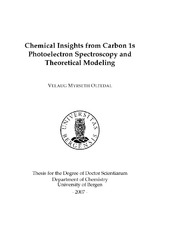| dc.description.abstract | Inner-shell ionization energies provide local probes of the charge distribution in molecules and of the ability of a molecule to accept charge at specific sites. As such, core-ionization energies are related to and may provide insight into other chemical properties that depend on the same ability. X-ray photoelectron spectroscopy (XPS) is the preferred tool for exploring core-ionization energies. In the present work, synchrotron radiation was used to acquire photoelectron spectra of several carbon-containing molecules in the gas phase. Carbon 1s ionization energies are of special interest because of the vital role of organic molecules in life processes. A prerequisite for obtaining accurate ionization energies is access to reliable methods for calibration of the energies. This work has been concerned with establishing procedures for very accurate calibration of C1s ionization energies. With today’s instrumentation, it is possible to obtain high-resolution photoelectron spectra that reveal details of the fine structure which have not been observed previously. The fine structure may be very complex, due to contributions associated with the inequivalent carbons in a molecule, as well as vibronic structure. To assign such a spectrum and obtain chemical shifts, one is dependent on theory to prepare lineshape models for each carbon in the molecule. In this thesis, several approaches for modeling vibronic progression in XPS measurements of hydrocarbons were tested. A relatively simple model for taking into account effects of vibronic coupling in the spectra was developed. This model is expected to work well also for larger, more complex systems. With this tool, it is possible to assign photoelectron spectra and obtain chemical shifts for the different carbons in a molecule with high accuracy. It is now believed that vibronic structure arising from core-ionization of hydrocarbons is well understood. This knowledge has been applied to various molecular systems of chemical interest. It is shown that core-ionization energies may provide insight into chemical properties such as proton affinity and reactivity, and how these properties are influenced by a methyl substituent. Experience from gas-phase XPS is also found to be of considerable use in assignment of adsorbed-state photoelectron spectra. | en_US |
